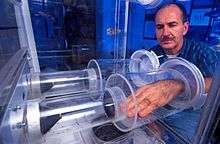Olfactometer
An olfactometer is an instrument used to detect and measure odor dilution. Olfactometers are used in conjunction with human subjects in laboratory settings, most often in market research, to quantify and qualify human olfaction.[1] Olfactometers are used to gauge the odor detection threshold of substances. To measure intensity, olfactometers introduce an odorous gas as a baseline against which other odors are compared.

Many scientists use the term "olfactometer" to refer to a device used to study insect behavior in presence of an olfactory stimulus. It consists of a tube with a bifurcation (with "T" or "Y" shape) where an insect walks and decides between two choices, usually clean air versus air carrying an odor. This is why this device is also called dual choice olfactometer.[2][3]
Alternatively, an olfactometer is a device used for producing aromas in a precise and controlled manner.
Flow-olfactometer
Description
A flow-olfactometer is a difficult instrument for creation of well defined, reproducible odor or pain stimuli in the nostril without tactile or thermal stimulation. Stimulus rise time is fast enough to allow for recording of olfactory evoked potentials (OEPs).
How a flow-olfactometer works
A flow-olfactometer produces a constant heated and humidified flow of pure air. This air flow runs continuously to the subjects nose. For the length of the stimulus pulse the continuous air flow is replaced by a bloc of odorized air.
Dynamic dilution olfactometer
The new generations of dynamic dilution olfactometers quantify odors using a panel[4] and can allow different complementary techniques: odor concentration and odor threshold determination, odor suprathreshold determination with comparison to a reference gas, hedonic scale assessment to determine the degree of appreciation, evaluation of the relative intensity of odors, and allow training and automatic evaluation of expert panels.
The most recognised olfactometry standard is currently the EN13725 standard. Analyses performed by olfactometers are often used in site diagnostics (multiple odor sources) performed with the goal of establishing odor management plans.
Field Olfactometry
Field olfactometry can be a useful tool in validating odor complaints, or determining odor levels for various locations. Field olfactometers provide the same basic function of a laboratory olfactometer but are designed to be used by a single panelist to measure ambient odors. To be classified as a field olfactometer the device must be able to provide accurate and controlled dilution of the ambient air with odorless air and present the diluted sample to the panelist at controlled and positive air flow.
The Nasal Ranger, developed by St. Croix Sensory, is a common brand of field olfactometer used in wastewater treatment plants, industrial facilities, and marijuana grow houses.[5]
Verifying Odorant level in Natural Gas
Natural gas odorant concentrations are required to be readily detectable at one-fifth of the lower flammable limit of the gas by state and federal regulation. Many gas companies utilize olfactometers to verify this standard. The ASTM has published a standard test method for this determination.[6]
References
| Wikimedia Commons has media related to Olfactometer. |
CEN 13725:2003 - Air quality - Determination of odour concentration by dynamic olfactometry; German version EN 13725:2003.
- Electronic noses, GC/MS systems, and human sensory panels provide varied solutions for product-odor concerns
- Beavers JB, McGovern TP and Adler VE (1982) Diaprepes abbreviatus: Laboratory and field behavioral and attractancy studies. Environ Entomol 11:436-439
- Otálora-Luna F, Hammock J, Alessandro RT, Lapointe SL, and Dickens JC (2009) Discovery and characterization of chemical signals for citrus root weevil Diaprepes abbreviatus. Arthropod-Plant Interact. DOI 10.1007/s11829-009-9058-7.
- Zarra T., Reiser M., Naddeo V., Belgiorno V., Kranert M. (2018). "A Critical Evaluation of the Influence of Different Panel Composition in the Measurement of Odour Concentration by Dynamic Olfactometry".CS1 maint: multiple names: authors list (link)
- https://www.popularmechanics.com/science/a30535438/nasal-ranger/
- "ASTM D6273 - 08 Standard Test Methods for Natural Gas Odor Intensity". West Conshohocken, PA: ASTM International. 2008. Retrieved July 15, 2012.